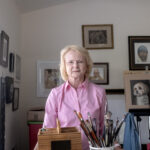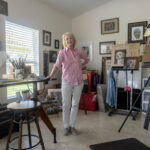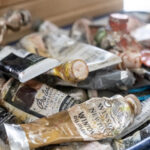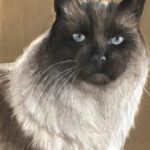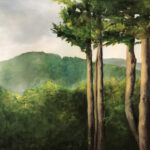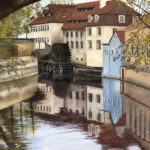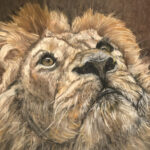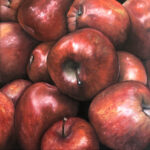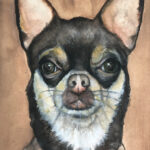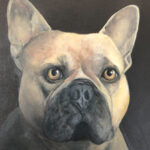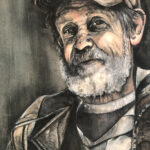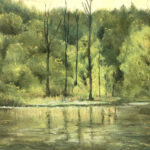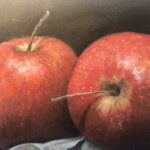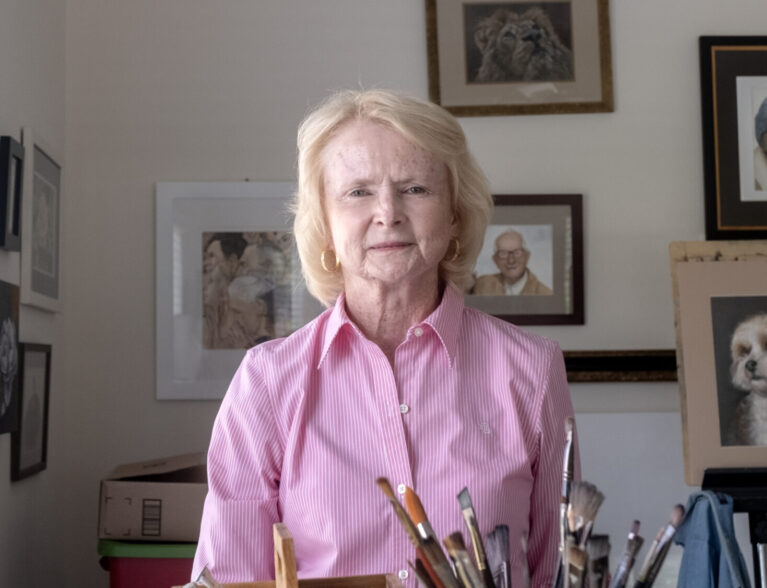
“Painting makes my heart sing,” says Lynn Brouillette, who turned her full attention to her artwork after retiring from a nursing career.
While she had occasionally painted earlier in life, it wasn’t until after she moved to Florida from New Jersey and started taking art classes that she began to take it seriously.
“Wonderful instructors help you to see a different look,” says Brouillette. “The painting has to come alive.”
One of those instructors, a watercolorist, taught her how to employ colors to their best effect and introduced her to mediums other than oils, which had previously been her preference.
“She was such a blessing,” says Brouillette, “She set me in the right direction, and I’ve been painting ever since. She was great.”
Brouillette regularly took classes at the Vero Beach Museum of Art pre-pandemic, and even via Zoom during it, but now, having not yet re-enrolled, she says she misses it.
“I like the camaraderie of having other people around you who are painting as well. Being able to walk up to someone and say, ‘Oh you got that color perfectly.’ And then they’ll come up to your painting and say, ‘You know, in that corner, a little lighter could be just fabulous.’ And you do it and it’s like, whoa, you never even saw that.”
Inspiration for her work can come from virtually anywhere. She explains, for instance, that she once viewed a gentleman down on his luck.
“But you can see in his eyes that burning fire. And everything has that. You see fruit on a table, and the light is hitting just right. You just can’t walk by. You have to make a note of that; this is going to be something one day,” she says.
A fan of travel, she recalls visiting numerous museums on a trip to Europe, marveling at works by the masters created centuries ago.
“After all this time, the colors were still alive, deep and rich. You could see the life in these paintings, especially the portraits. You could actually feel what they were seeing at that time,” says Brouillette.
She was particularly intrigued by the richness of their palettes, despite the fact that they had neither wealth nor the ready availability of paints and supplies.
“Maybe they shared colors. They made the colors themselves from natural things found on earth, yet they are so preserved even today. These paintings seem to be looking back at you.
After all this time, they are still so alive and vibrant.”
Brouillette works in oils, watercolors and pastels, finding oils the easiest to work with and the most forgiving, although also the most time-consuming.
“Oil is a long-term commitment. You really have to let it dry in between,” she says.
She prefers to use oils for still life and landscape paintings, putting layer upon layer to get the depth and color exactly right. The result is almost photographic, with perfect attention to detail, yet with a richness unmatched by photography.
However, she explains, “watercolor works best for delicate flowers. Pastels, and sometimes watercolor, on the other hand, lend themselves to portraits of animals and children. Pastel works well when painting eyes and facial details, but in a more delicate way than oils.”
With her animal portraits, every hair is carefully drawn to make fur that is so lifelike, it’s tempting to want to touch it.
“I enjoy painting animals and people the most,” says Brouillette. “I do a lot of dog portraits; people seem to really enjoy that. I love to paint people because they come in all flavors. You look at a person and say, ‘Oh my goodness, what life has this person lived?’ You take in what they are wearing and their demeanor, and you think, he deserves to be put into a picture.”
Having moved into a new home, Brouillette is happy she can now devote one room to a studio, rather than painting on her dining room table.
“It is so wonderful to not have to pack up. To just leave and come back and pick up where I left off,” she says. She especially likes that she can now have multiple projects going, returning to pieces after some time to view them with fresh eyes.
“I start doing something else and I say, aha, I know what the problem is with that painting.
Your paints are all still out, you fix it, and there you go. You’re on your way.”
Brouillette says she enjoys participating in art shows, not just to sell her works, but to have them validated by the viewers’ reactions.
“When you work alone a lot, it’s hard to get a good idea that you’re moving in the right direction, that you are capturing what you need to capture.”
Her artwork has been shown in various galleries, including in a juried show at the A.E. Backus Museum & Gallery in Fort Pierce, honored to have had it accepted because of their standards.
“The Backus is very stringent about how a picture presents itself; not so much the content, that’s a different subject altogether. They are very specific about how it’s framed, how it’s mounted, how any kind of borders are in there,” she explains. “I judge my acceptance by their standards, so if I get in, it’s like, yes, I’ve met the cut. All is well with the world.”
Brouillette has also shown her work at the Vero Beach Museum of Art, Vero Beach Art Club Gallery and Marketplace, Gallery 14, the Emerson Center and the Lighthouse Gallery in Jupiter.
Photos provided and by Joshua Kodis

